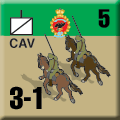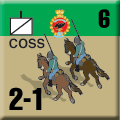| August 1914, Fall of Empires:
The Tsarist Army of 1914, Part One
By Robert D. Williams
December 2024
 Organization Organization
The Russian Army in 1914 generally used a “square” organization; that is, four subunits composed a unit. During the course of the war, a triangular organization was gradually introduced.
Infantry
The smallest infantry subunit was the squad (otdeleniye). Four squads made up a platoon (vzvod), four platoons, a company (rota). A company on a wartime establishment had 235 enlisted men: one first sergeant, one quartermaster sergeant (kaptenarmus—a position, not a rank), four senior sergeants, 14 junior sergeants, 20 corporals, 180 privates, and 15 non-combatant personnel (orderlies, accountants, bakers, cooks, grooms, and company clerks). The company was usually commanded by a captain with two to three junior officers to assist him. These officers apparently usually commanded half-companies, but could sometimes function as platoon leaders. The positions of first sergeant and platoon leaders were usually filled by re-enlisted NCO’s with the rank of podpraporshchik, fel’dfebel’, or starshi unter-ofitser. The squad leaders were junior sergeants or corporals.
 Four companies made up a battalion; four battalions a regiment. A battalion was usually commanded by a colonel or lieutenant colonel; regiments by colonels. The battalions in each regiment were numbered 1 – 4, the companies being numbered sequentially for the entire regiment, 1 – 16. Besides the 16 line companies, each infantry regiment also had a machine gun detachment, a reconnaissance detachment, a communications detachment, and a non-combatant company. The communications detachment and the reconnaissance detachment were composed of men drafted from the line companies. Four companies made up a battalion; four battalions a regiment. A battalion was usually commanded by a colonel or lieutenant colonel; regiments by colonels. The battalions in each regiment were numbered 1 – 4, the companies being numbered sequentially for the entire regiment, 1 – 16. Besides the 16 line companies, each infantry regiment also had a machine gun detachment, a reconnaissance detachment, a communications detachment, and a non-combatant company. The communications detachment and the reconnaissance detachment were composed of men drafted from the line companies.
The regimental machine gun detachment (komanda) consisted of four sections (vzvody), each of two guns, with a strength of approximately 84 men: the detachment commander, two to four junior officers, a first sergeant, four senior sergeants, six junior sergeants, eight corporals, 52 privates, six transport privates, and two workmen. A machine gun crew consisted of one commander, one gunner, one assistant gunner, two ammo-bearers, and one driver.
 Rifle regiments contained only two battalions, except for the Siberian rifle regiments, which, like the infantry regiments, contained four battalions. Otherwise, a rifle regiment did not differ from an infantry regiment in either equipment or organization. Rifle regiments contained only two battalions, except for the Siberian rifle regiments, which, like the infantry regiments, contained four battalions. Otherwise, a rifle regiment did not differ from an infantry regiment in either equipment or organization.
Four regiments made up a division (commanded by a lieutenant general), the regiments being permanently assigned to a particular division in numeric order. Thus, the 16th Division was composed of the 61st, 62d, 63d, and 64th Regiments. Although the division was divided into two brigades, each consisting of two regiments, in practice, the division commander usually issued orders to the individual regiments directly, bypassing the brigade commander. Rifle regiments were usually organized into independent brigades consisting of four two-battalion regiments, but some rifle regiments, notably the Siberians, were organized into rifle divisions.
Each infantry or rifle division or independent rifle brigade had either a light artillery brigade (six eight-gun batteries) or a light artillery battalion (three eight-gun batteries) attached, which usually had the same number as the division or brigade to which it was assigned.
An infantry corps usually consisted of two infantry or rifle divisions or four rifle brigades with their attached artillery, a battalion (divizion) of howitzer artillery, a sapper battalion, and an aviation detachment of six aircraft.
Cavalry
 A cavalry squadron was composed of four troops (vzvody) and consisted of five officers (a squadron commander and up to four junior officers) and 144 enlisted men: one first sergeant (vakhmistr), four senior and seven junior sergeants, one quartermaster sergeant, three trumpeters, eight corporals, and 120 privates. The squadron commander would be a captain (rotmistr). Junior officers could command half-squadrons or troops. A cavalry squadron was composed of four troops (vzvody) and consisted of five officers (a squadron commander and up to four junior officers) and 144 enlisted men: one first sergeant (vakhmistr), four senior and seven junior sergeants, one quartermaster sergeant, three trumpeters, eight corporals, and 120 privates. The squadron commander would be a captain (rotmistr). Junior officers could command half-squadrons or troops.
Three squadrons formed a battalion (divizion), two battalions a regiment. The Life-Guard Horse and the two Guard Cuirassier Regiments of the 1st Guard Cavalry Regiment, however, had only four squadrons. Two cavalry regiments formed a brigade, two brigades a division. Each cavalry division contained one dragoon, one uhlan, one hussar, and one first-line cossack regiment. Each division contained a regiment of each type with the same number as the division: for example, the 5th Cavalry Division contained the 5th Dragoons, the 5th Uhlans, the 5th Hussars, and the 5th Don Cossacks. The dragoon and uhlan regiments formed the 1st Brigade, the hussars and cossacks the 2d. (the various designations of dragoon, hussar, and uhlan were purely formal, there being no difference in training, tactics, equipment, etc.). A cavalry division also contained one horse artillery battalion (divizion) of two six-gun batteries and a machine gun detachment, the latter organized the same as an infantry machine gun detachment.
Cavalry divisions could be assigned to armies or to infantry corps or organized into cavalry corps for conducting special operations, such as raids.
Artillery
 Artillery was divided into light, mountain, howitzer, and heavy field. Light and mountain units were further divided into foot and horse. Batteries were divided into two-gun sections (vzvody) and grouped into battalions (diviziony), which were further grouped into brigades. Artillery was divided into light, mountain, howitzer, and heavy field. Light and mountain units were further divided into foot and horse. Batteries were divided into two-gun sections (vzvody) and grouped into battalions (diviziony), which were further grouped into brigades.
Light artillery was composed of three-inch (76.2mm) guns, Model 1902, in eight-gun batteries. Three batteries made up a battalion, and two battalions a brigade. Batteries assigned to rifle brigades or divisions were called “rifle artillery.” Horse artillery batteries contained six guns and were grouped into battalions of two batteries. Mountain batteries had the three-inch (76.2mm) mountain gun, Model 1909, which was lighter and could be disassembled and packed on horses. Foot mountain artillery battalions consisted of two eight-gun batteries; horse mountain artillery battalions of two six-gun batteries. All these various light artillery units were intended for direct fire.
Corps and army-level artillery was intended for indirect fire. Corps artillery consisted of one battalion of twelve 48-line (122mm) light field howitzers, Model 1909 or 1910, organized into two six-gun batteries. Each army was assigned one battalion of heavy field artillery consisting of two batteries of six-inch (152mm) howitzers, Model 1910, and one battery of 42-line (107mm) guns, each battery containing four guns.
Artillery batteries were organized somewhat differently depending on their guns and type, but all batteries had about five or six officers: the battery commander (lieutenant colonel), two senior officers (captains), and two to three junior officers (podporuchiki to shtabs-kapitany), who performed the duties of assistant battery commander and section commanders.
A light field artillery battery in wartime had a battery first sergeant, 48 gun crewmen, 24 drivers, eight transport NCO’s with the rank of sergeant, 24 caisson crewmen, and 36 caisson drivers. In addition, a battery had three quartermaster sergeants, two to three trumpeters, a transport sergeant, a reconnaissance section, observers, telephone operators, and riding masters, plus the usual non-combat personnel.
Cossacks
 The cossacks were organized somewhat differently than the regular line cavalry and also varied slightly between the different “hosts” (voyska)—Don, Kuban, Terek, Astrakhan, etc.—however, in general, a cossack regiment consisted of six companies (sotni), grouped into two battalions (diviziony) of three companies. The cossacks also had their own reserve system, in which only the first-line regiments were maintained in peacetime (for example, 17 regiments of Don Cossacks), but upon mobilization the men forming the second and third-line regiments would be called up, effectively tripling the size of the peacetime host. The cossacks were organized somewhat differently than the regular line cavalry and also varied slightly between the different “hosts” (voyska)—Don, Kuban, Terek, Astrakhan, etc.—however, in general, a cossack regiment consisted of six companies (sotni), grouped into two battalions (diviziony) of three companies. The cossacks also had their own reserve system, in which only the first-line regiments were maintained in peacetime (for example, 17 regiments of Don Cossacks), but upon mobilization the men forming the second and third-line regiments would be called up, effectively tripling the size of the peacetime host.
A Don Cossack regiment consisted of a commander (a colonel), two assistant commanders (lieutenant colonels), six company commanders (yesauly), six junior officers in each company (khorunzhi to podyesaul), one first sergeant per company (usually a podkhorunzhi), 40 senior and 40 junior sergeants per per regiment, 18 trumpeters, 18 corporals, and 750 privates.
You can order August 1914 right here.
You can order Fall of Empires right here.
Infantry Attacks Package
August 1914
Fall of Empires
Franz Josef’s Armies
Winter’s Battle
Black Mountain
Retail Price: $266.95
Package Price: $215
Gold Club Price: $172
Experience the Infantry Attacks Package right here.
Sign up for our newsletter right here. Your info will never be sold or transferred; we'll just use it to update you on new games and new offers.
|
